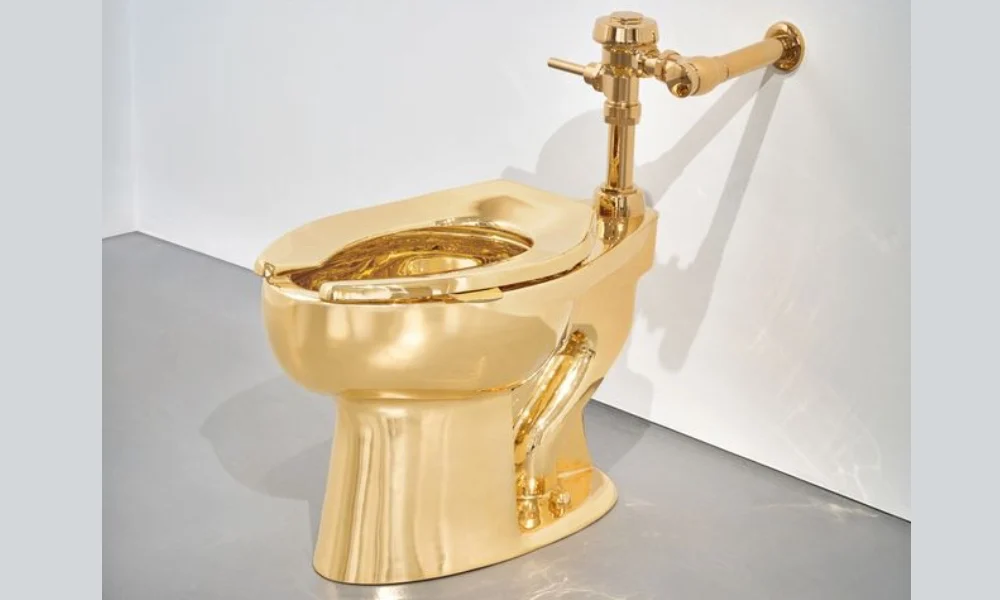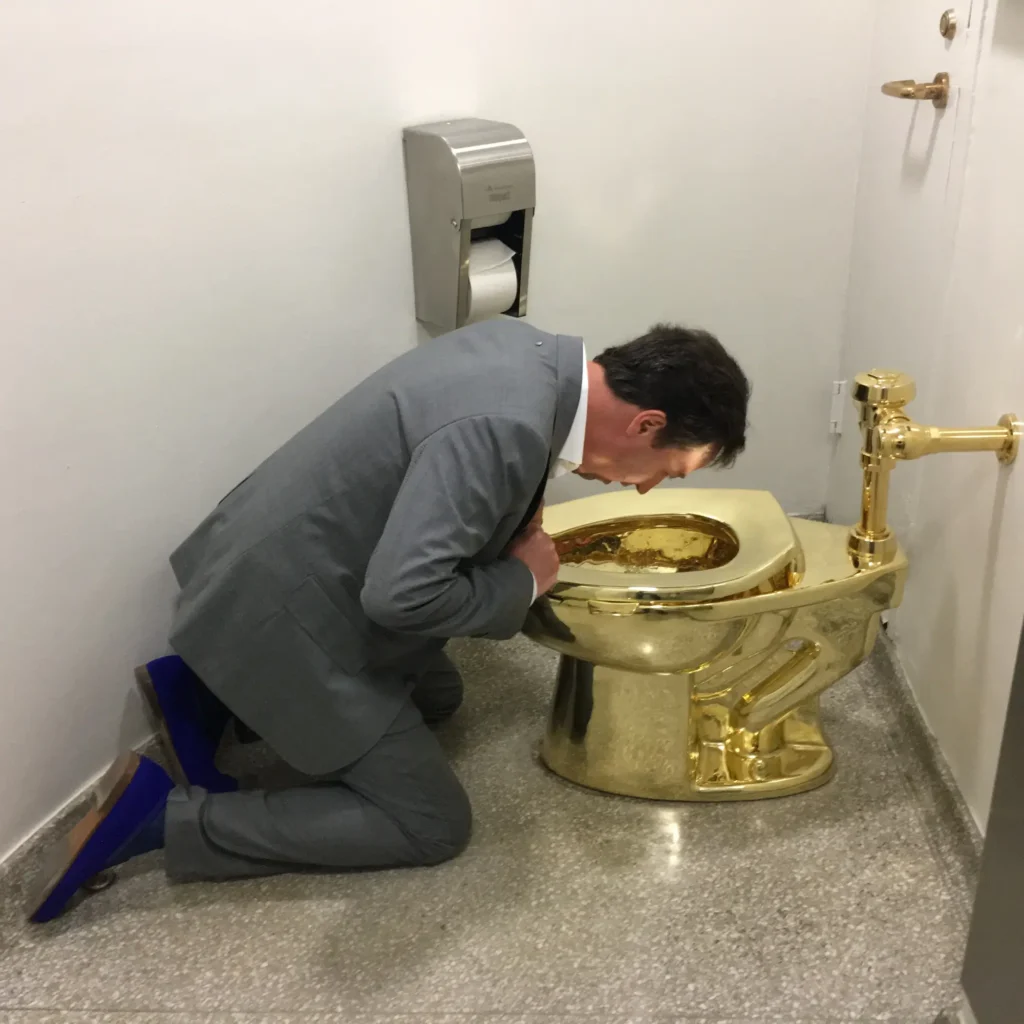When Maurizio Cattelan first unveiled America at the Solomon R. Guggenheim Museum in 2016, it caused a sensation. A fully functioning toilet sculpted from 18-karat gold, the work invited museumgoers to quite literally sit upon luxury. Now, nearly a decade later, the infamous artwork is returning to the spotlight — and the market. On November 18, 2025, America will head to auction at Sotheby’s New York, with bidding expected to start around $10 million. Its weight — 101.2 kilograms, or roughly 223 pounds — ensures that even its raw material value is staggering. But as with all of Cattelan’s creations, the value goes far beyond gold.
flow
At first glance, America seems like the ultimate absurdity: a toilet made entirely of solid gold. Yet the piece is quintessential Cattelan — provocative, ironic, and rooted in biting social critique. The artist, known for works such as the taxidermied horse Novecento (1997) and the hanging pope La Nona Ora (1999), has always toyed with the boundaries between reverence and ridicule. With America, he distilled this tension into the most basic of human fixtures.
Cattelan’s choice of material was as deliberate as his choice of object. Gold, the universal symbol of wealth, power, and excess, transforms an everyday utility into an emblem of privilege. Installed in a restroom rather than on a pedestal, the toilet confronts viewers with the uncomfortable overlap of luxury and necessity. It literalizes inequality: anyone can use it, but only a few could ever afford it.
When first exhibited at the Guggenheim, visitors were invited to use the toilet as they would any other. Over 100,000 people reportedly queued for the experience. The title, America, added another layer — a not-so-subtle commentary on consumerism, status, and the idea that wealth can become a form of spectacle. In Cattelan’s own words: “Whatever you eat, a $200 lunch or a $2 hot dog, the results are the same, toilet-wise.”
idea
Unlike most conceptual installations, America retained its function. This decision is key to its impression. By allowing real bodily interaction, Cattelan blurred the line between observer and participant. The toilet became both sculpture and performance, its use turning the viewer into a collaborator in its satire.
The decision to keep the piece operational also underscored Cattelan’s interest in collapsing hierarchies. In the museum’s architecture — Frank Lloyd Wright’s pristine spirals — the toilet existed as an intrusion of the real, the vulgar, and the human. It forced audiences to reconsider what constitutes dignity in art. Can something designed for waste also embody opulence?
In this duality lies the genius of America: a piece that is simultaneously priceless and profane. Its brilliance is not only in the metal but in the mirror it holds up to society’s obsession with wealth and spectacle.
transient
The mythology of America expanded dramatically after its second major exhibition. In 2019, the piece was installed at Blenheim Palace in Oxfordshire, England — the birthplace of Winston Churchill. It was an ironic setting: a golden toilet within one of Britain’s grandest estates. Visitors once again lined up to experience it, but the work’s run ended abruptly and spectacularly.
Just days after opening, America was stolen in the middle of the night. Thieves broke into Blenheim Palace, unbolted the toilet, and tore it from its plumbing, flooding the historic building. The heist became international news, not only because of the audacity of stealing an artwork worth millions, but because it seemed to fulfill Cattelan’s own sense of absurd humor. The artist initially joked that the theft was a performance piece, later clarifying, “I wish it were.”
To this day, the stolen version has not been recovered and is believed to have been melted down. The disappearance only deepened the legend — transforming America from a symbol of luxury to one of loss, greed, and irony come full circle.
a return
Now, six years later, America is set for its most public moment yet: its auction debut at Sotheby’s. The work heading to sale is another edition — one of the few remaining. The auction house expects bidding to start at roughly the current gold value, around $10 million, though the final hammer price could far exceed that. The material itself sets a financial floor, but the conceptual value — its fame, story, and notoriety — will drive the premium.
Sotheby’s has billed the work as “one of the most influential artworks of the 21st century,” positioning it alongside Cattelan’s best-known provocations. The sale reflects how contemporary art often operates within the same speculative economy it critiques. A toilet meant to satirize excess has now become a trophy for collectors — a meta-commentary Cattelan would no doubt appreciate.
social
At its core, America isn’t about gold — it’s about what gold represents. Cattelan takes the language of luxury and collapses it into an object associated with privacy, waste, and the unglamorous. The result is a sharp critique of capitalism and inequality. It invites viewers to question who gets access to beauty, comfort, and status — and whether those privileges are as hollow as a gilded bowl.
The work’s title is equally loaded. America functions as both an accusation and an observation. It caricatures a society obsessed with opulence and self-importance while pretending to be democratic. Everyone was welcome to use the Guggenheim’s gold toilet, but the gesture exposed how few truly share in wealth’s spoils. In that sense, the artwork doesn’t merely parody America — it is America, shiny and self-reflective, glamorous and grotesque.
leg
Born in Padua, Italy, in 1960, Maurizio Cattelan rose to fame through his blend of satire and spectacle. Often dubbed the “court jester” of the art world, his work dismantles institutions from within. He has made sculptures of the Pope struck by a meteorite, of himself hanging from a museum ceiling, and of Hitler kneeling in prayer. Humor is his weapon, but behind it lies a deep moral unease about power, faith, and human folly.
America condenses decades of his practice into one perfect symbol: an object of worship and waste, admired and ridiculed in equal measure. It exemplifies Cattelan’s philosophy that art’s role is not to comfort but to disturb — to make audiences confront their complicity in the systems they laugh at.
mrkt
That America is now returning to the auction block feels like the final twist in its story. A work designed to lampoon excess will now be sold for millions to the very elite it mocked. Yet this paradox is what keeps Cattelan’s art alive. He doesn’t offer moral clarity — he offers reflection. The toilet’s sale, like its creation, blurs the line between critique and complicity.
Collectors will not just be buying a gold object; they’ll be buying a cultural meme, a piece of living mythology. Whether installed in a museum, a private home, or a vault, America remains a mirror to its surroundings. Wherever it sits, it asks the same question: what are we really flushing away when we worship wealth?
fin
As America heads to auction this November, it embodies the full arc of contemporary art in the 21st century — a dance between irony and indulgence, critique and commerce. Maurizio Cattelan has transformed a toilet into a timeless allegory: one that glitters with both humor and truth.
In the end, the gold toilet is less about gold and more about reflection. To look into America is to see ourselves — our appetites, our absurdities, and our collective fascination with the beautiful waste of luxury.
No comments yet.









